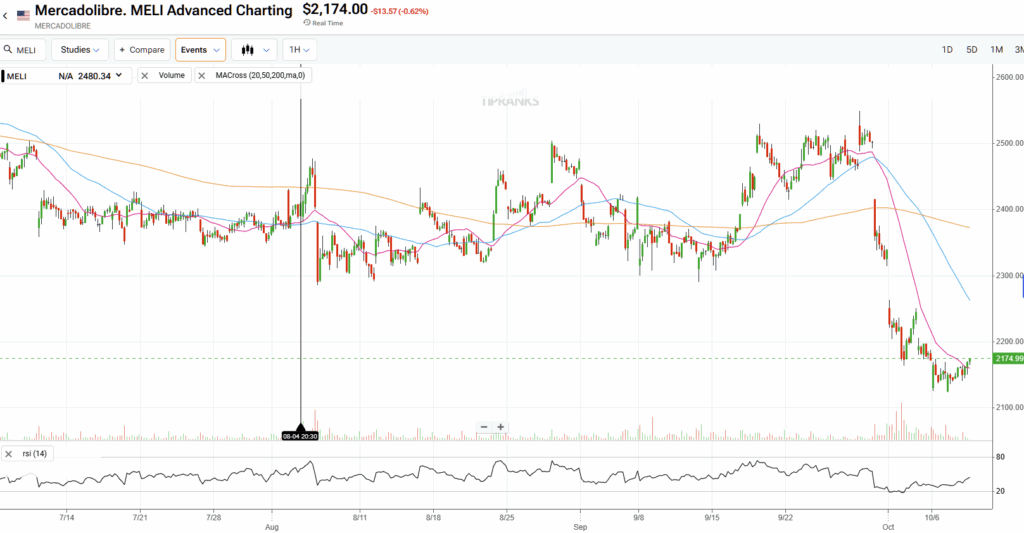MercadoLibre (MELI) shares have tumbled roughly 15% since the company reported Q2 earnings on August 4, when investors were rattled by margin compression driven by rising shipping costs amid intensifying competition. After trading in a steady range between $2,300 and $2,500 throughout September, the stock has taken a proverbial cliff dive in October and now sits at $2,174 per share.
Elevate Your Investing Strategy:
- Take advantage of TipRanks Premium at 50% off! Unlock powerful investing tools, advanced data, and expert analyst insights to help you invest with confidence.
Despite the sudden pullback and raised eyebrows among its shareholders, management continues to execute a smart growth strategy—boosting sales volume through free-shipping initiatives while keeping fixed costs largely in check. The recent decline appears to be a temporary setback rather than the start of a long-term issue. I remain confidently Bullish on MELI, expecting a steady recovery in the months ahead.
MELI Fights Back to Retain Its Dominant Position
In Q2, MELI’s revenue rose ~34% year-over-year to $6.8B, but net income came in starkly below the consensus expectation by about 14%. With investors opting for short-term profit-taking, value players like myself couldn’t help but notice the opportunity as the weeks passed following the Q2 print.
This has all taken place because in June, MELI cut Brazil’s free shipping threshold from 79 reais to 19 reais. This was a double-edged sword, given that gross merchandise volume rose by 29% year-over-year, but fulfillment costs inflated. Nonetheless, management had no other choice, as aggressive expansion attempts by China’s Temu and Shein, as well as entrances into LatAm by Shopee and Amazon (AMZN), required a moment of strategic defense.
Currently, MELI dominates the LatAm markets, and therefore, management is prioritizing user retention and customer loyalty within its ecosystem over short-term margins. Thankfully, the business can later monetize through fintech and advertising, while also capitalizing on its newly burgeoning gross merchandise volume.
Put bluntly, foreign competitors face structural disadvantages, as Latin American logistics costs can be up to 35% of the product value, compared to just 8–10% in developed markets. MELI avoids the customs delays and import duties that plague its international competitors, maintaining its position as the dominant first mover in a lucrative digital-physical infrastructure market in Latin America.
Fundamental Growth Is Robust Despite Present Headwinds
MELI is delivering remarkable growth across all segments. Items sold grew by 31% year-over-year in Q2, fintech assets under management doubled, and the company’s credit portfolio expanded 91%. Moreover, advertising revenue grew 38% year-over-year.
When looking at the consensus, things get even better. On average, analysts are expecting about 40% annualized normalized EPS growth and 25% annualized revenue growth over the next few years. That’s a massive growth runway, considering the stock is now trading at a 14-day RSI of nearly 30. In my view, MELI is oversold with plenty of buyers at ~$2,100 per share.
My entry point was $2,190, and I plan to hold the investment for several years, aiming for an annual return of around 25% in a base case and 30–35% in a bullish scenario. My conviction is driven by MELI’s strong fundamentals, favorable sentiment among U.S. investors, and the company’s exceptional growth trajectory and robust long-term outlook.
Risks Don’t Offset the Structural Growth Opportunity
Firstly, before considering the potential downside, it is essential to acknowledge that MELI has established a world-class infrastructure moat that is difficult to challenge. Mercado Envios, the shipping and logistics arm of MercadoLibre, handled 57% of shipments regionwide and over 75% in Mexico in Q2, which has driven record same-day delivery performance. This is simply unmatchable in the region at this time and drives economies of scale.
That said, the subsidy wars from Chinese entrants into Latin America could extend longer than anticipated, and the main risk here is both prolonged competition and operational fatigue/strategic missteps.
There’s also growing cyclical risk, as the company’s over $9 billion credit portfolio now makes it far more vulnerable to delinquency in the event of a recession. This opens up the potential for earnings volatility, which could lead to a bumpy stock price, given that the company trades at a forward non-GAAP ratio of nearly 50x. That said, high growth and high volatility often go hand in hand.
What is the Target Price for MELI Stock?
On Wall Street, MELI carries a consensus Strong Buy rating based on 11 Buys, two Holds, and zero Sells. The average MELI stock price target of $2,890.38 indicates ~32% upside over the next 12 months. This confidently reaffirms my bullish stance, showing that my outlook is heavily supported by consensus industry opinion.

MELI Stock Remains Too Solid to Ignore
Few stocks in the market induce as much conviction as MercadoLibre. With powerful forward growth prospects, a proven track record, and exceptionally strategic management, there’s little not to like. I’m targeting a 30% annual return over the next several years and view the current margin pressures as both temporary and an ideal buy-the-dip opportunity, while others remain cautious.
In my view, MercadoLibre doesn’t just merit inclusion in a portfolio—it deserves to be a core, overweight position that anchors returns with resilience, high alpha, and long-term durability.


















